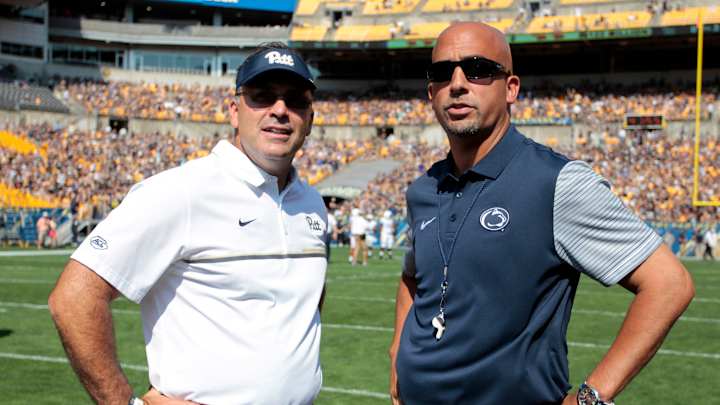Penn State-Pitt is Back! Sort of.

Penn State and the late Joe Paterno finally have their Eastern Conference. For Penn State, that means a consistent path to the playoffs.
Also, Penn State-Pitt is back!
Sports Illustrated Pat Forde has assumed the role of College Football Commissioner, recalibrating the game with his “Realigning America” project. In it, Forde reimagines college sports into 10 conferences that combines the Power 5 and Group of 5 leagues, resets programs based largely on geography and seeks to retain some established rivalries.
In this new model, Penn State joins the 12-team Yankee Conference, which looks an awful lot like the Eastern Conference that Paterno proposed nearly 40 years ago. Here’s a look at the Yankee Conference, with each team’s protected rival in parentheses.
Penn State (Ohio State)
Navy (Air Force)
Syracuse (NC State)
Boston College (Wake Forest)
Maryland (Virginia)
Pittsburgh (WVU)
Army (Hawaii)
Temple (SMU)
Rutgers (Duke)
Buffalo (Kent State)
Connecticut (Georgia State)
Massachusetts (FAU)
You’ll notice the similarities between the Yankee Conference and Paterno’s proposed league, which also included Pitt, Boston College, Syracuse, Temple, Maryland and Rutgers. In 1981, Paterno nearly helped broker a deal joining these programs in a football/basketball league that, at the time, would have been among the strongest in the country.
But the parties disagreed over terms, the negotiations broke down and the teams went their separate ways. Jake Crouthamel, the former athletic director at Syracuse, wrote in a Big East retrospective that Penn State applied to join the conference in 1982. The members voted 5-3 against the application, one vote shy of approving Penn State.
In 2009, former Big East Commissioner Mike Tranghese told the New York Times that refusing to admit Penn State was the conference’s “one major mistake.” He reportedly told Dave Gavitt, the Big East’s founding commissioner, that, “We will rue the day over this decision.”
"You look back on it, and the whole of college athletics would be changed now," Tranghese told the Times.
The Yankee Conference revives that change, though its football competitiveness is quite tilted. Penn State would form the conference’s geographic and competitive core, at least for football, and would renew some longstanding rivalries. But there are drawbacks, not the least of which involves recruiting.
So let’s delve further at what a Yankee Conference would mean for Penn State.
PROS
Playoff potential: As the teams currently are constructed, Penn State is the conference favorite. Penn State has a lifetime win rate of 68 percent against the other 11 members and is 34-5 against them since 2000. That includes a 10-1 record vs. Temple, a 6-0 record vs. Rutgers and a 5-1 mark against Maryland.
A rivalry renewed: The Penn State-Pitt series rejoins the annual schedule, perhaps even as the regular-season finale. Despite calls from both sides that the rivalry had run its course, the two Penn State-Pitt games of the recently concluded four-game series both topped 108,000 in attendance. The 2017 crowd was announced at 109,898, one of the 10 highest in Beaver Stadium history.
Retain its regional recruiting core: Penn State already is a regional recruiting power and holds a significant presence in New Jersey and Maryland, though Rutgers and the Terps seek inroads with new coaches. Winning Yankee Conference titles would make Penn State the undisputed recruiting monster of the region.
Big markets, ease of travel: The Yankee Conference includes Boston, New York, Philadelphia and Washington D.C., all desirable media markets for fans and young college alumni. Further, Penn State’s travel budget would be slashed, as the team could bus to more than half its road games. Check out the Yankee Conference map, whose footprint is tightly confined.
Protected rival: This is important. Penn State’s next step is moving into Ohio State’s realm as a perennial playoff contender, and the teams dueled for titles and recruits the past four years. Playing this game annually protects a new rivalry, both on the field and in recruiting.
CONS
National recruiting limitations: Penn State is pressing to recruit more in Florida and Texas, where some of the better prospects are located. But they might not be inclined to play in a cold, provincial conference. Or perhaps recruits will be attracted to the potential of conference titles and playoffs?
No network: The Big Ten Network is the most established revenue source among the conference networks, largely because of its affiliations with some of college football’s biggest brands. The Yankee Conference has nice teams, but brands? Not as much, though Army-Navy is a nice addition.
Schedule: Let's face it. The schedule is loaded with lots of non-conference-style games. Penn State has played Temple, Buffalo, Army, Navy and Massachusetts in non-conference games since 2000. Fans tolerate a few of those annually, for home-game and revenue purposes. But six a year might be a stretch.
A rivalry renewed: Pitt-Penn State is a relic, some fans suggest, not an annual pursuit. Penn State hasn’t really shown much interest in renewing the series after its recent four-year run ended. Would the game really recapture the electricity it held in the 1970s and ‘80s?
Have any thoughts on the Yankee Conference? Are there better options? Share in the comments.
Get the latest Penn State news by joining the community. Click "Follow" at the top right of our AllPennState page. Mobile users click the notification bell. And please follow AllPennState on Twitter @MarkWogenrich.

Mark Wogenrich is the editor and publisher of Penn State on SI, the site for Nittany Lions sports on the Sports Illustrated network. He has covered Penn State sports for more than two decades across three coaching staffs, three Rose Bowls and one College Football Playoff appearance.